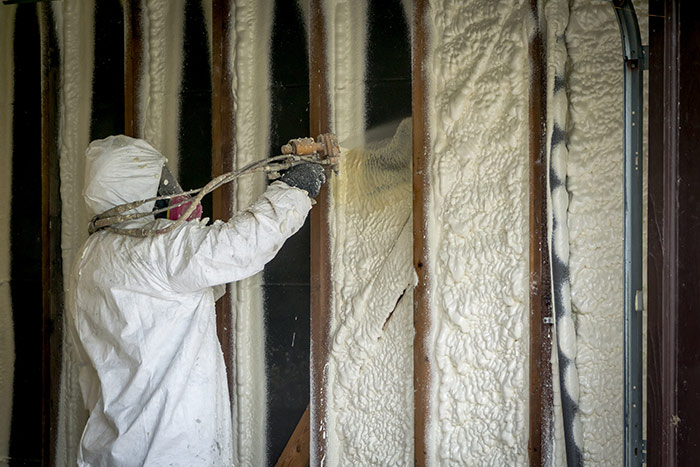Spray foam insulation is a commonly used form of insulation as it is relatively easy to apply and can be used to correct previous insulation mistakes. Homeowners often use it to reduce energy costs, but many worry about the effects of breathing spray foam and whether or not it is dangerous.
If you plan to install spray foam in your home or building, you likely have your own worries about the product’s safety. It is wise to be cautious. Spray foam insulation can be detrimental to your health (1).
The EPA (2) lists the dangers of spray foam to include eye and lung irritation, sore throat, shortness of breath, and fever. Taking proper precautions during insulation can minimize the adverse effects.
Read on to learn more about the dangers of spray foam, the ways to protect yourself, and how to mitigate the effects if accidentally inhaled.
Why Breathing Spray Foam Is Dangerous?
As with any type of chemical application, it is imperative that you read and follow all of the safety information provided by the contractor or in your DIY kit. Before beginning an application, it is best practice to read the SDS (Safety Data Sheet) for the particular brand and type of spray foam being used on your property.
Note: A Safety Data Sheet (3) or SDS was previously called a Material Safety Data Sheet, and it is a document containing detailed information about a hazardous chemical prepared by the manufacturer. It describes both the physical and chemical properties of a product.
You can also seek information from the SPFA (4) (Spray Polyurethane Foam Alliance), the federal government, or companies that install spray foam. Each of these avenues will help you better understand safe handling and best practices. However, some variables can affect the application of spray foam in individual settings; these variables should be taken into account and properly evaluated. Consult a professional installer if you have questions or concerns.
Dangers of Spray Foam
Exposure to spray foam chemicals — in mist or vapor form — can lead to accidental breathing, ingestion, skin contact, and eye contact.
Inhalation of spray foam can cause
- Irritation of the lungs, throat, and nose
- Coughing
- Sore throat
- Runny nose
- Tightness in the chest
- Shortness of breath
- Generalized respiratory tract sensitization
- Wheezing
- Increase in asthma symptoms
- Life-threatening asthma attack (5)
In addition to breathing dangers, spray foam can also lead to irritation of the eyes and skin, skin sensitization, blurred vision, and irregular heartbeat (6).
As you can see, you must avoid inhalation and excessive exposure to spray foam.
How To Protect Yourself From Spray Foam Breathable Particles?
You can mitigate many of the risks associated with spray foam contact by understanding proper application techniques and obeying all safety recommendations.
Manufacturers recommend waiting a period of time after spray foam has been applied before entering the building. Heeding the curing rate guidelines will help mitigate (7) much of the risk. Toxic fumes and spray foam particles will linger in the air for around 24 hours (see safety sheet for exact recommendations). The fumes and particles can also travel within the building to other areas where the spray foam was not installed, making them unsafe as well.
During the application of spray foam, proper protective clothing and gear are recommended. OSHA requires those working with spray foam insulation to wear PPE (8) — the required elements depend on the risk of exposure for each worker.
Recommended PPE may include:
- Air-purifying respirators or supplied-air respirators
- Safety goggles or face shields
- Chemical-resistant gloves (rubber, nitrile, neoprene, PVC, or butyl)
- Chemical-resistant boot covers or boots
- Coveralls with attached hood
- Disposable chemical-resistant coveralls
Adjacent workers who do not enter the immediate area where the spray foam is being applied may not need as much PPE as the person who is directly spraying the foam.
When applying spray foam as a DIY project, you will need to use your own best judgment when choosing your PPE. If you are the person spraying the foam, disposable coveralls will help protect your skin and clothes from the mist, and a hooded respirator will prevent accidentally inhaling the foam. Eye protection will keep any of the foam from splashing into your eyes. If applying spray foam in an exterior location, an air-purifying respirator may suffice, but it should not be used for an indoor application.
What to Do If You Inhaled Spray Foam?
In the unfortunate event that spray foam is inhaled, the victim should immediately be moved into an area with fresh air — ideally outdoors. They should be allowed to rest in a position most comfortable for breathing. If their breathing becomes labored, oxygen (9) may need to be administered.
Poison control or a medical professional should be called as soon as respiratory symptoms are noticed. Those with asthma (10) may be especially afflicted by difficulty breathing post-exposure.
If spray foam comes into contact with exposed skin, any contaminated clothing should be removed, and the area should be rinsed with clean water immediately. Medical attention is necessary if the area becomes red, a rash is noticed, or blisters form. Symptoms from exposure may be delayed.
If spray foam comes into contact with the eyes, they should be carefully rinsed with clean water for several minutes. Contact lenses should be removed (11) immediately and discarded. If the eyes continue to feel irritated, a medical professional should be consulted.
If spray foam is ingested, poison control or a doctor should be consulted immediately. DO NOT induce vomiting.
Sources
- Centers for Disease Control and Prevention. (1996) Preventing Asthma and Death from Diisocyanate Exposure DHHS. https://www.cdc.gov/niosh/docs/96-111/
- United States Environmental Protection Agency. Health Concerns about Spray Polyurethane Foam. https://archive.epa.gov/epa/saferchoice/health-concerns-about-spray-polyurethane-foam.html
- OSHA. (2012) Hazard Communication Standard: Safety Data Sheets. https://www.osha.gov/sites/default/files/publications/OSHA3514.pdf
- Spray Polyurethane Foam Alliance. Home Page. https://www.sprayfoam.org/
- Washington State Department of Labor and Industries. (2017) Isocyanate-based foam and Work-Related Asthma. https://lni.wa.gov/safety-health/safety-research/files/2017/42_03_2017_isocyanate_foam.pdf
- Cambridge University. (2011) A sticky situation: management of spray polyurethane foam insulation in body orifices. https://www.cambridge.org/core/services/aop-cambridge-core/content/view/EDC8EA827134C3697815B5BFEA074708/S1481803500000762a.pdf/sticky_situation_management_of_spray_polyurethane_foam_insulation_in_body_orifices.pdf
- United States Environmental Protection Agency. Vacate and Safe Re-Entry Time for Spray Polyurethane Foam Application. https://archive.epa.gov/epa/saferchoice/vacate-and-safe-re-entry-time-spray-polyurethane-foam-application.html
- United States Department of Labor. Personal Protective Equipment. https://www.osha.gov/personal-protective-equipment
- The American National Red Cross. (2011) Administering Emergency Oxygen. https://www.lummi-nsn.gov/userfiles/332_m3240082_AdministeringEmergencyOxygenFactandSkill.pdf
- Journal of Occupational and Environmental Medicine. (2012) Asthma Induced by Exposure to Spray Polyurethane Foam Insulation in a Residential Home. https://journals.lww.com/joem/fulltext/2012/03000/asthma_induced_by_exposure_to_spray_polyurethane.3.aspx
- Centers for Disease Control and Prevention. (2005) Contact Lens Use in a Chemical Environment. https://www.cdc.gov/niosh/docs/2005-139/pdfs/2005-139.pdf





